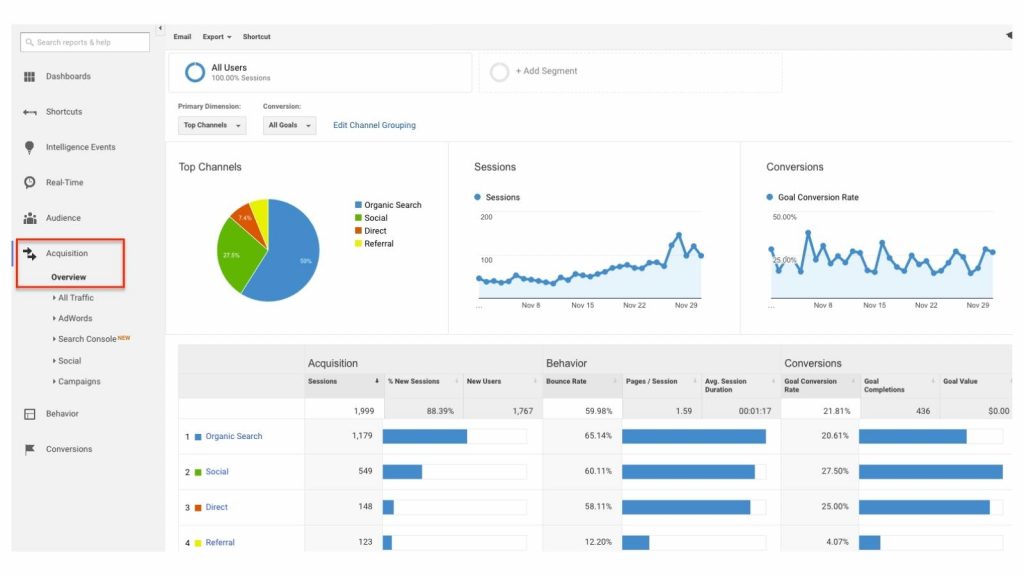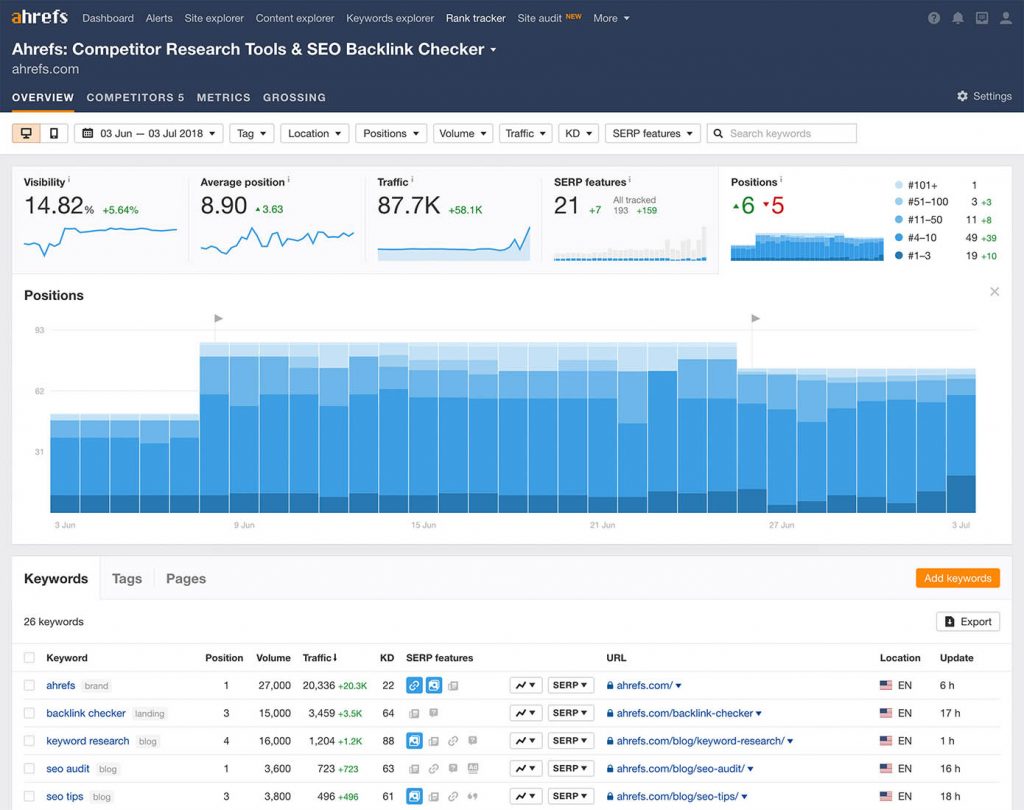How do you know when you have the best blog post among the uncountable articles out there on the internet? It may be time to start making your blogging KPIs which are similar to content marketing KPIs.
Or, better yet, what does the success of a blog mean to you? For most bloggers, success means crafting an engaging post that captivates and draws the reader in.
On a broader level, the success of most blogs depends largely on increased traffic, leads and conversions.
But how do you know when your blog gains enough traction to be successful? It’s easy to keep writing without knowing whether you’re getting any results.
But if you want to make money blogging, you have to use certain key performance indicators (blogging KPIs) or action deliverables to rate your blog post’s performance.
Table of Contents
What Are Blogging KPIs?
In blogging, key performance indicators are metrics that tell you how successful your blog content is and whether it resonates with your audience. You can tell how your blog is performing by looking at a few crucial metrics:
- Your audience size
- How your audience engages with your content
- How your audience comes across your blog
Why are blogging KPIs important? You’re writing to promote your business or your clients. Since you may not have direct contact with the customer, you need to know how the blog is performing to adjust your writing or change your approach if necessary.
That’s where blogging KPIs come into the picture. Use them to track your blogging efforts and whether they’re aligning with your business’s digital marketing objectives.
How To Use Blogging KPIs

KPIs are used to rate the performance of a blog. To ensure you get your desired results, here are some ways to take advantage of blogging KPIs:
- Attach your KPIs to a value. Let’s say you want to increase your monthly sales by 25%. To get there, you may frequently post on social media or make specific posts with a call to action linked to a particular product. However, if you plan to achieve this goal, set up an indicator with a value that tells you if your plan is working or not.
- Define your own KPI. Ensure KPIs fit your overall goals as a business. This could mean higher checkouts for an eCommerce website or getting on sales calls for a SaaS company. Remember that the true essence of blogging is to engage and connect with your target audience—so link your KPIs to engagement.
- Don’t look at every KPI from the sales perspective. Not every blog post will result in a real return on investment—at least, not one you can easily track. But blogging is about brand awareness, so look at your KPIs more broadly. Before creating a post, identify the stage of the user you’re trying to reach and what you want from them. As they start to recognize your brand, gradually take them through the different stages of a user’s journey by providing value with your blogging till you get to the conversion stage.
10 Blogging KPIs You Must Track
While the blogging KPIs vary depending on your unique business objectives, here are ten commonly used metrics experts use.
1. Blog Traffic
Traffic is the most obvious, if not the most important, metric to track. It leads to engagement, lead generation, and everything else that comes after. Whether you’re targeting customers at the brand awareness stage, engagement, or conversion stage, getting them to your blog is key.
Blog traffic refers to the people that visit your blog from time to time. There will be months you’ll see sudden traffic spikes, whereas other months will see low traffic. Ignore the inconsistent surges and dips and concentrate on the average growth monthly or yearly.
Keep tabs on which blog posts generate the most traffic to learn about the kind of content your audience likes. This also helps you plan future blog posts in your content hub.
2. Traffic Source Blogging KPIs
Traffic sources or channels tell you where your audience is coming from. These can be organic, paid, direct, or through campaigns. Look deeper and measure which keywords or social media platforms bring you traffic.
This KPI identifies which specific marketing efforts are working well and which are not worth your efforts and money.
For instance, look at the traffic coming in from your social media links and compare the results with the traffic from email marketing campaigns. You’ll know which campaigns are successful and which might need more work to improve their ROI.
A valuable tool for measuring traffic sources is Google Analytics. The page views data filters by channel so you can appropriately tag the channels your traffic comes from.
On the Google Search Console you will see if you are showing up in the AI overviews as well.

Image Source: Larry Ludwig
3. Time Spent On The Site
The number of time users spends on your site indicates their interest in your content. The more time they spend, the more engaged they feel—and the more likely it is that they’ll return.
If the time spent on the site is low, it can mean visitors aren’t making it to the end of your content. If that’s the case, you should check if you’re attracting the right traffic or rethink your content strategy.
Other factors may contribute to low time spent on sites, such as page loading speeds, ad pop-ups, and visual content.
4. Pages Per Visit
This engagement metric indicates how users interact with your blog. Just as you want users to spend time engaging with your content, you also want them to visit other pages on your site.
You may want to check out your internal linking if you have high site traffic but few pages per visit. Make it easy for your users to click through by creating more valuable content worth linking to.
More clicks mean effective content, which means more time spent on your website.
5. Returning Visitors Increases KPIs for Blog Posts
This KPI shows you how useful your content is to your audience based on whether they keep coming back for more.
Keep track of how these returning visitors grow over time and which blog pages drive the returns.
You may want to write more about those specific blog topics or optimize your posts for keywords that drive return traffic.
6. SERP Ranking Important Blogging KPIs
Search engine results page (SERP) ranking is the average position of your blogs on search engines. It’s a quick metric that shows how authoritatively Google views your blog and if your content is worth ranking in SERP features for relevant keywords and phrases.
Ahrefs Rank Tracker is an excellent tool for measuring SERP ranking. With this, you can gain a clear picture of SEO results and determine whether it’s working or if it’s time to improve your on-page optimization.

Image Source: Ahrefs.
7. Social Sharing
This metric reveals what social pages are most important to your audience and what type of content performs well on different social platforms.
For example, content that performs well on Twitter X may do poorly on Facebook. I’ve found over the years for Inspire To Thrive, X performs Facebook almost every month for the past 14 years!
These insights improve your social media strategy based on your target audience’s preferences.
8. Conversion Rate
Conversion is a metric for all actions a user takes after reading your post. Depending on the context, this includes email sign-ups, downloads of a free ebook, filling out a lead-generation form, or sales.
Determine the conversion rate by dividing the number of conversions you get by the number of site visitors within the same time frame.
Tracking this rate over a long period helps you understand how changes to your blog and content strategies affect your business.
9. Bounce Rate Affects KPIs for Blog Posts
Bounce rate measures the percentage of readers that come to your site, have little to no interactions, and leave.
A high bounce rate means your audience doesn’t resonate with the content on your blog.
In that case, monitor articles with lower bounce rates, and adjust your content to relate to those topics.
Alternatively, you encourage users to stay by offering them links to similar articles, videos/podcasts, or a sidebar with exciting information.

A good bounce rate is considered to be between 25%-40%. A lower bounce rate helps you rank higher in the SERPs, leading to more traffic and conversions.
If it’s higher than 70%, it means you may need a new approach. (Unless people are buying quickly from a web page.)
10. Active RSS Subscribers
Getting your blog noticed is good. But true success comes from turning one-time readers into loyal and raving fans who will share your content and expand your reach to potential readers.
How? Use the number of people subscribed to your blog via RSS as a blogging KPI to measure your blog’s success.
RSS is like a newsfeed that lets subscribers get notified whenever you publish a new blog post. The number of RSS subscribers indicates how many loyal and dedicated readers you have attracted over time.
Sow Your Blog Post Seeds Carefully
Blogging is a long-term initiative. It takes time to succeed.
To ensure you’re on the right track to blogging success, keep measuring these important KPIs. Google Analytics is one of the easily accessible tools you can use for tracking your content marketing KPIs.
Since it can be integrated with other marketing tools to generate leads and traffic, it’s a good place to start.
The internet is constantly changing, so a great strategy today may not be great tomorrow. The key is to keep an eye on these metrics and analyze them regularly.
With the results of your analysis, you can enhance your blogging strategy to eventually meet your overall business goals.
You can also use blogging services from Inspire to Thrive to expand your digital footprint and grow your business. Get in touch to get engaging SEO-focused blog posts that bring fantastic results.
FAQ: Blogging KPIs vs. Metrics and How They Matter
KPIs (Key Performance Indicators) measure how well you’re achieving your key business goals. Metrics track specific aspects of your blogging activities but aren’t always tied to major business objectives.
KPIs show how your blog aligns with business goals. They help you focus on what truly drives growth and success
Sure! Some common blogging KPIs include organic traffic, bounce rate, conversion rate, social shares, and average session duration.
Metrics to keep an eye on include page views, unique visitors, time on page, click-through rates (CTR), and comments.
Identify your business goals first. Then select KPIs that directly support those goals. For example, if brand awareness is your goal, focus on social shares and organic traffic.
Review them at least monthly. Depending on your blogging activities, weekly reviews might be necessary to stay on top of trends and make quick adjustments.
Yes, your KPIs should evolve with your business goals. As your blog grows and your objectives shift, update your KPIs to match your new priorities.
Tools like Google Analytics, SEMrush, and Ahrefs are great for tracking both KPIs and metrics. They offer detailed insights and data visualization.
Focus on KPIs since they align with your business goals. However, don’t ignore metrics. They provide the data needed to understand and analyze your KPIs.
Consistently create high-quality content, use SEO best practices, engage with your audience, and analyze your data. Make adjustments based on what the data shows to improve performance.
- How To Snooze Someone On Facebook In 2026 To Avoid Drama - January 3, 2026
- Instagram Insights Explained: Simple Analytics That Grow Your IG Account - January 3, 2026
- Getting Meta Verified: Does It Work? Inspire To Thrive Interviewed 19 Users for Answers - December 31, 2025





Hi Lisa,
These points are on point!
There is a science that goes behind successful blogging. And when say successful, we are talking about revenue. If you are looking to build a niche blog with the intent to build profitable revenue, these metrics will be your driving force. It’s a process that needs to be taken seriously.
Thanks for these super helpful tips!
Thank you Freddy. Yes, blogging can be a science in itself. You are welcome, which tip did you like the most?
Hello Lisa,
Fab Post. Bounce rate is a big concern among newbie bloggers. Being a blogger our main focus is on increasing the dwell time on our blog to increase conversions. You have shared helpful insights about blogging KPIs. Thanks a lot for sharing
Regards,
Vishwajeet Kumar
Hi Vishwajeet. Oh yes, for sure until you start to sell products. Then you want them to make a purchase and that doesn’t often take long on the site. Or if they find what they want fast and come back later for more information. Thanks for your comment Vishwajeet and make it a great day!
Time spent on site and the bounce rate both point to either highly targeted traffic or non-targeted traffic. Each helps bloggers dial in because if people spend little time on your blog only to bounce quickly, you have a problem. Traffic may seem high but if this high volume of people leave fast or barely stick around this crowd does not follow your blog loyally and certainly doesn’t buy your stuff, hire you, drive referral business, or become a brand advocate.
Excellent post Lisa.
Ryan
Hi Ryan, If they make a purchase quickly it’s not a problem.) But if you are not selling anything then you would want them to spend more time on your site. I find having video embeds helps keep them around. Thanks for your input, Ryan. I hope you are enjoying the new area you are in.